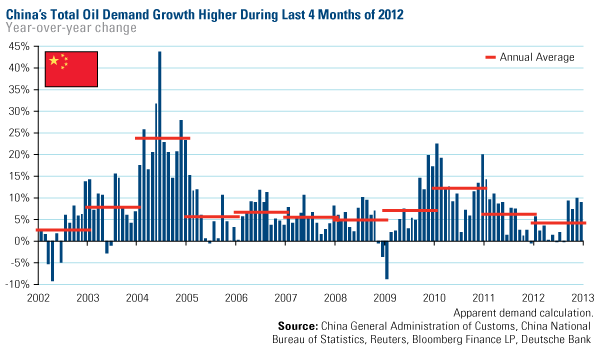Energy and Natural Resources Market Radar (February 4, 2013)

Strengths
• Oil prices gained this week with Brent rising to the highest level since October 2012, reflecting renewed optimism about economic growth, U.S. dollar weakness and the Fed's pledge to maintain its asset purchase program. Tensions in the Middle East added to price action on reports of Israeli strikes on the Syrian-Lebanese border.
• China's oil demand rose by 4.2 percent in 2012, making it the weakest growth rate since 2002. However, demand in the final four months of last year recovered sharply to average growth of 9 percent compared with growth of just under 2 percent in the first eight months.
• In the U.S., new orders for durable manufactured goods increased by 4.6 percent month-on-month in December. The rise, the seventh in the last eight months, was well ahead of average forecasts of about 2 percent.
• Japan’s manufacturing purchasing managers’ index (PMI) increased by2.2 points month-on-month in January. This marked a four month high and was the strongest month-on-month rise seen since May 2011.
Weaknesses
• The price of natural gas headed for its second-straight weekly loss, as cold weather at the start of February may fade by the month, cutting demand for the heating fuel.
• Chilean copper production fell about 2 percent year-over-year to about 513,000 tons in December, according to government data released this week.
• The price of platinum declined this week as investors rotated funds into the palladium market, pushing the metal to a new 52-week high.
Opportunities
• January has proved to be a good month for commodity index returns. This is in line with historical norms. Indeed since 2003, index returns have delivered positive returns 75 percent of the time in the first month of a new year. History would suggest this strength will continue throughout the first quarter so long as signs of global reflation remain intact.
• Central banks were net buyers of gold through 2012 as a whole, the latest IMF data shows, continuing a trend of recent years. The outlook is promising, as traditional central bank sellers look set to hold onto their gold reserves, while a number of forex-rich central banks in emerging markets add to theirs.
• A combination of supply worries and resurgent Chinese demand may prove to be a catalyst for the price of thermal coal, with floods interrupting Queensland production and higher industrial activity in China driving demand for power generation.
• The Hess Port Reading, New Jersey, refinery closure adds to an already sizable list of refineries around the world that have been mothballed in recent years. Closures peaked in 2012 with 1.6 million barrels per day of capacity that was permanently shut. More than 60 percent of U.S. refinery closures have been located in Petroleum Administration for Defense District 1 (PADD 1).
Threats
• Antofagasta’s announcement this week of a significant increase in its operating costs has brought the issue of inflation in copper mining costs back into focus.
• U.S. consumer confidence fell to a 15-month low in January, with the Conference Board's latest index reading reported at 58.6, down from 66.7 in December. The drop was attributed to the impact of an increase in payroll taxes and respondents' assessment of current labor market conditions and outlook also deteriorated.










